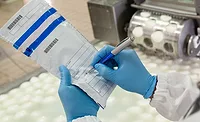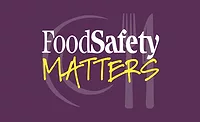Packaging and Labeling Requirements for Cannabis-Infused Edibles
Many similarities exist between the packaging and labeling of cannabis-infused edibles and those of food and pharmaceuticals

Image credit: lauraag/iStock / Getty Images Plus via Getty Images
Buying a cannabis-infused edible as a consumer is a nexus of food, dietary supplement, and pharmaceutical. The edible takes the form of a well-known food such as a gummy, baked good, chocolate, or beverage. The cannabinoids of cannabidiol (CBD), delta-9-tetrahydrocannabinol (THC), and others are labeled in a similar fashion as those of active ingredients in a dietary supplement. Even if the edible is purchased through an adult-use program, most cannabis-infused edibles are consumed for a pharmaceutical purpose, which may be as common as pain, sleep, or appetite management.
As of this writing, 40 U.S. states have a legal medical program and 23 states have both a legal medical program and a legal adult-use market. Cannabis is a federal Drug Enforcement Administration Schedule I substance1 (see marihuana, marijuana), making cannabis-infused edibles illegal at the federal level and leaving the U.S. with 40 different state codes. Cannabis-infused edibles are not legally defined as a food or dietary supplement at the federal level. The legal cannabis industry performs every step from seed to sale within the boundaries of state lines to avoid interstate commerce, and businesses must comply with the state code of their respective state of operation. Packaging and labeling requirements are found in the state code.
The majority of Americans (74 percent and counting)2 live in a state with a legal medical program, and according to the Pew Research Center, 48 percent of Americans live in a state with a legal adult-use market.2 The scale will be tipped to most Americans living in a state with a legal adult-use program, thanks to Minnesota legalizing adult use in May of 2023. Cannabis-infused edibles are sold through dispensaries, similar to the sale of pharmaceuticals from pharmacies. Each dispensary visit is a different experience, just like each food facility visit is unique. So far, there are no cookie-cutter Walgreens- or CVS-type dispensaries for cannabis products.
When purchasing cannabis-infused edibles, the receptionist at the dispensary will view your picture identification, such as a driver's license, to enter. Dispensary shopping is restricted to those 21 years of age and older. I have visited dispensaries where the reception is a locked area separate from the retail space. In other words: no identification, no entry. My adult son flew to California with me by going through TSA security with a paper copy of his driver's license, but he was not allowed entry into a dispensary!
Most dispensaries do not allow the handling of products and keep the products within glass cases. Look, but do not touch. Rarely will single packages be displayed on shelves in a dispensary. Planet 13 in Las Vegas is a large dispensary with multiple rows of glass cases.3 As you peer into the glass cases at the packaging, expect to see beautiful designs of graphics.
Many similarities exist between the packaging and labeling of cannabis-infused edibles and those of food and pharmaceuticals. Cannabis-infused chocolate can be either portioned into individually wrapped pieces or sold as a bar that is scored to snap off a single portion easily. When I first started buying cannabis-infused chocolate bars, I was disappointed to learn that I could not eat the entire bar, because I enjoy chocolate. This is exactly why the scoring is important—dosing. If the whole bar has 50 mg of THC and there are ten portions, each portion contains 5 mg. The standard recommendation for new adult use is to start with 5 mg of THC, wait up to 2 hours, and see if there is an effect. Cannabis-infused chocolate is made with the best-sourced ingredients; that chocolate bar will often cost more than $20 USD.
At the dispensary, after viewing the product, the consumer makes their way to the checkout lane. A budtender will take the order, which must be paid in cash. Expect an ATM in the corner to withdraw cash, or the dispensary may be set up with a credit card service. With Cannabis illegal at the federal level, cannabis businesses do not enjoy the luxuries of normal banking that we all take for granted. Congress is edging closer to passing the federal SAFE Banking Act in 2023.4 A plain, sealed bag will contain the order. Do not open the sealed bag! Take the bag somewhere private and inspect the contents there.
Looking for quick answers on food safety topics?
Try Ask FSM, our new smart AI search tool.
Ask FSM →
Packaging for Cannabis-Infused Edibles
Packaging for all cannabis-infused edibles must be designed to be:
- Functional and protective of the contents
- Opaque
- Portioned or individually wrapped
- Tamper-evident
- Child-resistant
- Unattractive to minors
- Unlike certain commercially available products.
Functional and Protective of the Contents
Cannabis-infused edibles require the same protection from their packaging as does any food in its packaging. Dietary supplements are often sold in white plastic bottles. The primary packaging is designed to maintain integrity and serve in the prevention of cross-contact of allergens, cross-contamination of pathogens, light penetration, and further deterioration of the product within a sealed material. The primary package material will carry labeling information and meet many of the following requirements.
Opaque
The white plastic bottles of dietary supplements and orange bottles of pharmaceuticals are excellent examples of primary packaging in which the contents are not seen or not seen clearly. When I was first learning about edibles and visiting dispensaries, I was frustrated not to see the product before purchasing because I was a novice and wanted to learn. Edibles are very expensive, and I could not purchase all of them! In the rare dispensaries where I could hold the product stored on a shelf, I still could not see the contents; the packaging was opaque.
As I pondered this requirement in the cannabis industry, I made analogies to my favorite snacks. I cannot see the contents of Reese's peanut butter cups or a Theo chocolate bar with its molded portions. I do not see Oreos in their package or beverages inside of cans at the time of purchase. I realized this requirement in the cannabis industry is common for our processed foods and beverages.
Portioned or Individually Wrapped
Like a pharmaceutical, dietary supplement, or over-the-counter drug, the dosage of cannabinoids is critical to the consumer. Great pains are taken in the manufacture of edibles to homogenize the cannabinoids so that every serving delivers the dose of labeled cannabinoids as would a tablet or capsule. For that reason, most edibles are individually wrapped, and each individual portion delivers the labeled dose. The cannabis industry is packaging-intense. Individual gummies from a jar deliver the labeled dose. If not individually wrapped, a cannabis-infused cookie may have score marks for portioning, and multiple-serving chocolate bars can be molded for snapping off pieces, with each piece delivering the labeled dose. Occasionally, however, I have come across products that do not conform to these guidelines (Figure 1).
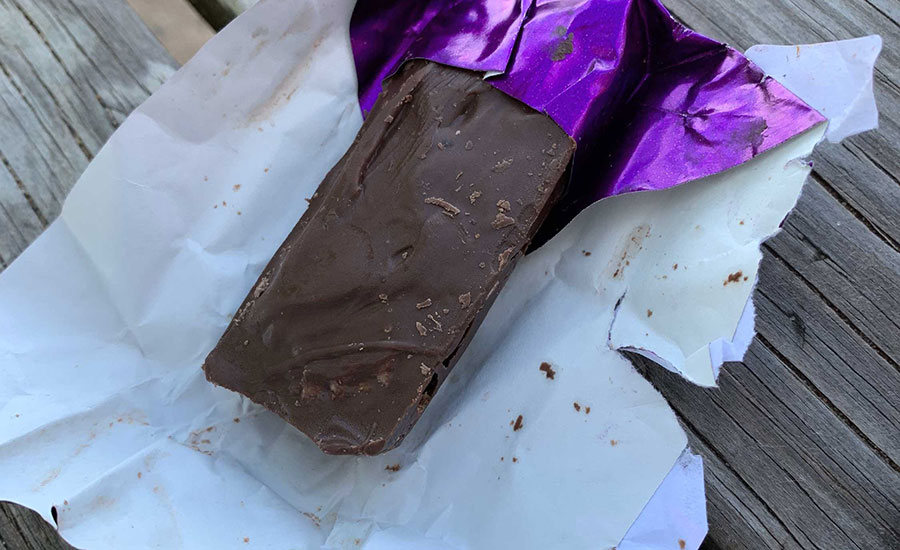
Tamper-Evident
Remember the last time you opened a bottle of acetaminophen, ibuprofen, or your daily vitamin? Maybe there was an external wrap around the lid and a seal to break after the lid was removed. The packaging of most chocolate is tamper-evident, once opened. An opened beverage cannot be re-sealed. The engineers in the food, dietary supplement, and pharmaceutical industries have developed brilliant tamper-evident packaging, and the cannabis industry is employing all of that and more. The need for tamper-evident packaging for edibles is the same as the need in all U.S. Food and Drug Administration (FDA)-regulated industries for the safety of the consumer and directly leads to the next requirement of child-resistant packaging.
Child-Resistant
A pharmaceutical in an orange bottle is child-resistant. Over-the-counter drugs and dietary supplements are packaged in child-resistant packaging. The seal under a bottle's cap can be hard to peel open, even for an adult. Unopened edibles stored in the home must be secure, and sealed, child-resistant packaging is required. Once opened, edibles must be locked away from children or resealed. Child-resistant caps and resealable pouches are heavily used in the cannabis industry.
The cannabis industry is often compared to the alcoholic beverage industry. Will Cannabis be taxed federally, like alcohol? Warnings are part of labeling for each product. The level of tamper-evidence and child-resistance in the alcohol industry is in no way close to that of the cannabis industry, and most would argue that Cannabis is safer than alcohol.5 Think of how alcoholic beverages are stored in a home with children. Minors have been taken to the emergency room after over-consumption of alcohol, and some have died. Unresponsive children have gone to the emergency room and recovered as the THC wore off, but no child has died from the consumption of a cannabis-infused edible. This is but one example of how the cannabis industry is held to a higher standard than analogous products.
One feature of the cannabis industry is the strife to operate with sustainability. The cannabis industry works with nature and does not want to harm the environment. The combination of tamper-evident and child-resistant packaging means that the cannabis industry uses a lot of packaging for the product contained. In Colorado, I purchased a box of chocolate at a dispensary. Back in my hotel room, I could not figure out how to open the "trap box" that held the chocolates. A "Houdini-level" sliding of parts seemed to be required. Still, to this day, I do not know how that box was to be opened. The original box was undeniably child- and adult-resistant, and then clearly tamper-evident, after I ripped open the box (Figure 2).
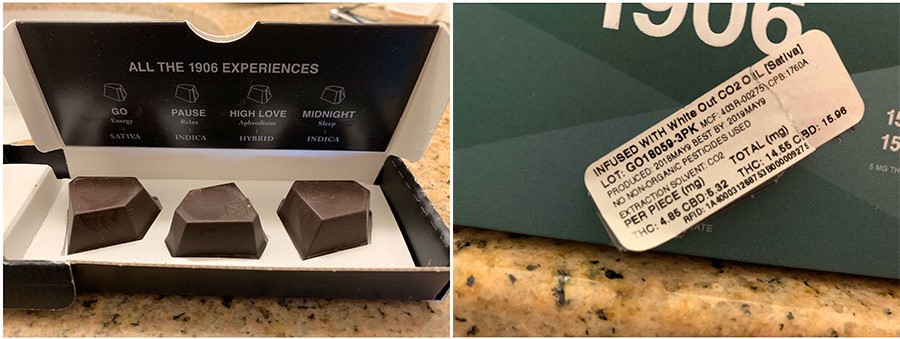
Nick McCormick is Chair of the National Cannabis Industry Association's Packaging and Labeling Committee. He is also a Packaging Consultant at a packaging and labeling firm with over 80 printing plants in North America. Packaging companies are striving to reduce the weight of packaging and, at the same time, improve the child-resistance of the material. McCormick explained, "Package evaluation starts at home with my two kids. I challenge them to get into the packages without scissors or other tools. Experience showed that packaging with recycled and compostable materials could easily be ripped open. So, our facility in North Carolina was independently certified to meet CFR 16.1700.20 for Poison Prevention Packaging, as required by multiple domestic states and Canada."
Unattractive to Minors
Cannabis-infused edibles, once visible and out of their packaging, must be unattractive. No gummy worms! No gummy bears! Any reminder of an already-established shape is not allowed. The best gummies are boring squares. The same concept is true for colors. Brightly colored edibles are more attractive, and the goal is for the edible not to be attractive to minors in shape, color, and packaging. Much of the packaging can still be considered beautiful. For example, with multiple-serving chocolate bars, the colors and graphics are bold, creative, handsome, and very adult. The packaging conveys that this is not a product for a child.
Unlike Certain Commercially Available Products
With familiar, global food brands like Chips Ahoy! or Coca-Cola, it is easy to visualize the brand and product-specific packaging. In your position in the food industry, you may deal with the prevention of food fraud as an economic burden to your company. State government agencies are on high alert for cannabis products that look like familiar brands, and yet national food brands are being imitated by some businesses in the cannabis industry. The trouble multiplies when packaging is attractive to children and the business risks access by a motivated child.
ASTM International
The author's 2020 book, Food Safety Lessons for Cannabis-Infused Edibles6, was written for two audiences: the cannabis industry and the food safety professional curious about the legal cannabis industry. Chapter 10 covers packaging and labeling, but it was not written with the collaboration of experts with direct experience in packaging and labeling in the cannabis industry. The void of federal regulations and implementation of 40 state codes drive organizations such as ASTM International to write standards for the cannabis industry.
Committee D37 on cannabis7 is an active assembly of expert volunteers working to write and publish standards for the cannabis industry. Many of the standards are adopted by states or countries and are used as models for writing regulations. Two recently published standards specifically address the labeling of cannabis products. The 2022 standard is discussed below. The 2023 ASTM standard D8449−23, Label Content and Style, Format, Location, and Prominence of Elements for Consumer Products Containing Cannabinoids,8 details labeling information for edibles among its 81 pages.
Labeling for Cannabis-Infused Edibles
In the same way that labeling for food is heavily regulated by FDA and exists as the primary means to communicate with a consumer, state codes detail labeling information on cannabis-infused edibles. Information on the principal display panel of a cannabis-infused edible aligns with that of a food to include a declaration of identity and weight. Separate panels show the nutrition information, serving size, number of servings per container, list of ingredients, allergen declaration, and declaration of manufacturer, as required of food.
The cannabis industry commonly uses QR codes to inform consumers of additional information where the package and label are not large enough. All edibles are made with a hold-and-test program and are not released for sale until they have passed laboratory tests. Some companies link the lab results and Certificate of Analysis (COA) of the edible to the QR code for each batch and include the strain of Cannabis.
Principal Display Panel
ASTM standard D8449–238 recommends the following information for the principal display panel:
- Declaration of identity: Common cannabis-infused edibles include gummies, baked goods, chocolates, and beverages. Most of these are low-water-activity, ready-to-eat or -drink products with a long shelf life. The principal display panel must state the common name of the edible.
- Declaration of Cannabinoids: The principal display panel must state the common name of the cannabinoids in the package, such as CBD, THC, or other cannabinoids. The label of one of my first experiences with cannabis-infused chocolate read 15 mg of THC. I was not experienced enough to know that 15 mg was the total amount of THC in the package and not the amount per piece of chocolate. I now know that a 5-mg portion is very common, so I should have guessed that there would be three pieces of chocolate in the package. When I finally opened the package (the same package shown in Figure 2), I saw three beautifully crafted pieces of chocolate, and each was expected to have 5 mg of THC. The ASTM standard 23.6.4.1 states, "The cannabinoid content declaration on the principal display panel for solid ingestible consumer products containing cannabinoids shall define: (1) The total cannabinoids per package/container in the form of a weight in milligram measurements."8 The same requirement of the total cannabinoids per package is recommended for non-discrete units like the liquid edibles of tinctures and beverages.
- Declaration of quantity: This is the total weight in grams of the contents.
- Universal symbol: ASTM Standard D8441/D8441M–22 International Symbol for Identifying Consumer Products Containing Intoxicating Cannabinoids9 is a symbol that the product contains cannabinoids. Volunteer members at ASTM collected and reviewed the warning symbols from state codes for comparison, followed ISO guidance documents on graphical symbols, and rolled out the International Symbol (Figure 3) in 2022 with the hope that all states and countries will adopt it.
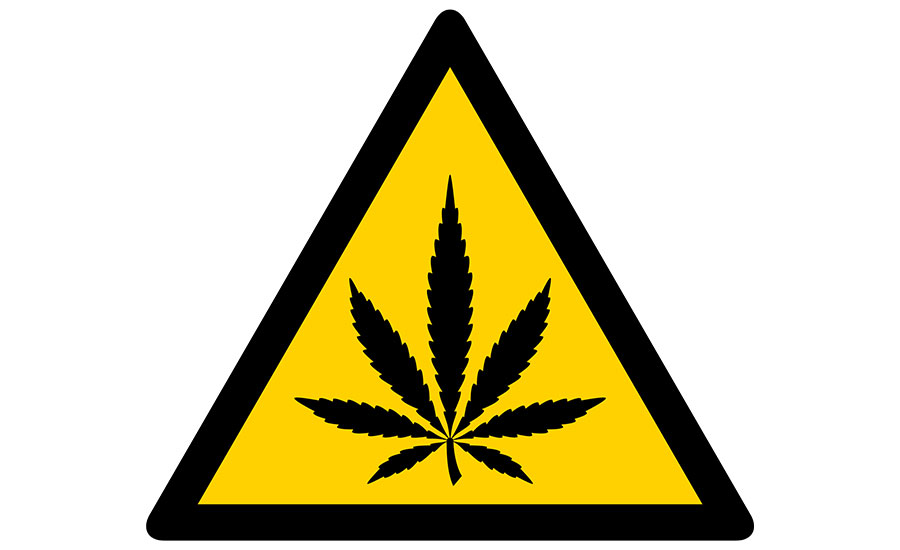
Separate Display Panels
ASTM standard D8449–238 recommends the following information on panels separate from the principal display panel:
- Nutrition information: The Nutrition Facts table and Supplement Facts table are heavily regulated for food and dietary supplements, respectively, and cannabis-infused edibles are not defined as food or dietary supplements. Unless a state specifically writes into the state code the use of a Nutrition Facts or Supplement Facts table, the nutrition information may be displayed in another format.
- Cannabinoid information label: In the same way the dietary supplement industry has Supplement Facts, the ASTM standard recommends the use of a Cannabinoid Facts table (Figure 4) with the amount of CBD, THC, and other cannabinoids.
- Declaration of terpenes (optional for adult use): Terpenes are naturally occurring compounds found in Cannabis that create aroma. The beauty of consumption of an edible is that it can be discrete without the smell associated with smoking.
- Warning statements: "Keep out of reach of children" is a common warning statement.
- Intended use: A suggested use for a tincture may be stated as, for example, "Place five drops under tongue or as directed by a medical professional. Hold 1–5 minutes before swallowing."
- Delayed intoxication warning: Release characteristics may be described as "delayed-release," "time-released," or "extended-release" due to active compounds in the cannabis-infused edible being metabolized and traveling to cannabinoid receptor sites in the body. Another type of warning may read, "Intoxicating effects may be delayed up to 2 hours and may persist for up to 8 hours."
- Storage instructions: Ambient storage or refrigerated storage will be specified on the label. Frozen products are rare in the cannabis industry.
- Use-by or best-before date: This is the same as for food. However, the cannabis industry currently does little in terms of shelf-life testing and testing for concentrations of cannabinoids at the end of shelf life.
- List of ingredients: This is the same as for food. However, the method of extraction for the cannabis extract as an ingredient should be specified. For non-edibles, the solvent for extraction may be non-food grade, such as butane. Solvents for extract bound for edibles must be food-grade, and supercritical carbon dioxide is used by the cannabis industry, but not exclusively. Ethanol and water extraction are also used.
- Allergen warning: This is the same as for food, but the cannabis industry is free to label more than the FDA's required nine allergens, as appropriate.
- Declaration of responsibility: This is the same as for food with the declaration of the manufacturer. Many cannabis-infused edibles are made with co-manufacturing, and the declaration of responsibility will instead be a distributor.
- Batch number with linear barcode: This is the same as for food.
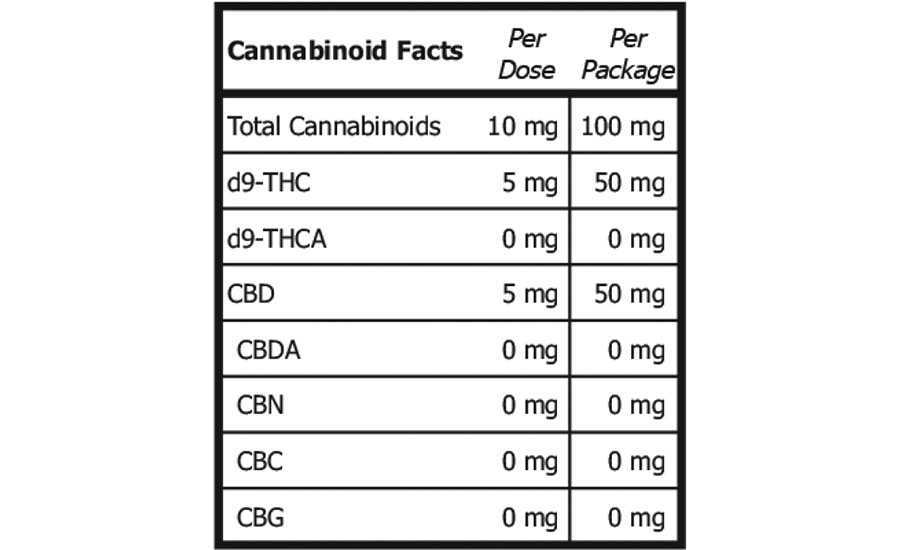
State regulators collaborate in the Cannabis Regulators Association (CANNRA) to ask questions, provide resources, and protect public health, for which they have been given authority. Lori Dodson is the Senior Advisor of the Maryland Cannabis Administration (MCA) and an active member of CANNRA. Maryland's adult-use program went live on July 1, 2023. At that time, Maryland did not require pre-approval of packaging and labeling; however, the MCA does require a manual approval process for quite a few product types including edibles. "Our team is continually learning and growing from best practices incorporated in other states," said Dodson.
Takeaway
Everything discussed in this article may not apply in your state. The 40 different state codes have 40 different requirements, with some lacking the details discussed in this article. A good mantra for the cannabis industry is: never assume. This means: Never assume that what is done in the food industry is followed in the cannabis industry. Never assume that the code of one state is duplicated in another state. Each of the states are doing the best they can, given their authority to regulate cannabis-infused edibles.
When considering the work of the food industry for implementation of a food safety plan for the control of hazards, it would be nice to require the same of cannabis-infused edibles. Without FDA authority at the federal level, states are left to manage on their own. Only a handful of states require Good Manufacturing Practices, and a few states refer to FDA Preventive Controls for Human Food. There is much work to be done in the cannabis industry and for the safety of cannabis products.
The cannabis industry is overtaxed, under-employed, and often stretched to its limit with the resources it has. Managers wear multiple hats within a business, and state codes can change and be enforced on any given day. Despite the challenges, people in the cannabis industry are entrepreneurs—motivated, eager, and passionate about their work. They believe in the benefits of the plant and the future of the legal cannabis industry.
References
- U.S. Drug Enforcement Administration. "Drug Scheduling." www.dea.gov/drug-information/drug-scheduling.
- Schaeffer, K. "7 facts about Americans and marijuana." Pew Research Center. April 13, 2023. www.pewresearch.org/short-reads/2023/04/13/facts-about-marijuana/#:~:text=Some%2048%25%20of%20Americans%20now,the%20drug%20for%20recreational%20purposes.
- Planet 13. "Welcome To Planet 13 Las Vegas Dispensary." www.planet13lasvegas.com.
- U.S. Congress. "S.1323—SAFE Banking Act of 2023." https://www.congress.gov/bill/118th-congress/senate-bill/1323.
- National Cannabis Industry Association. "Committee Insights: NCIA Mythbusters—Is Cannabis Safer Than Alcohol?" April 25, 2023. https://thecannabisindustry.org/event/55915/.
- Knutson, K. Food Safety Lessons for Cannabis-Infused Edibles. Academic Press: 2020.
- ASTM International. "Committee D37 on Cannabis." www.astm.org/get-involved/technical-committees/committee-D37.
- ASTM International. "D8449–23: Standard Specification for Label Content and Style, Format, Location, and Prominence of Elements for Consumer Products Containing Cannabinoids." 2023.
- ASTM International. "D8441/D8441M–22: Standard Specification for International Symbol for Identifying Consumer Products Containing Intoxicating Cannabinoids." 2022.
Kathy Knutson, Ph.D., PCQI, is educated in bacteriology, food science, and education. She speaks, writes, and trains on FDA FSMA compliance. She has trained over 500 Preventive Controls Qualified Individuals (PCQIs). She works with managers to write thorough hazard analyses, food safety plans, recall plans, environmental monitoring programs, and allergen programs. In 2020, she published her book, Food Safety Lessons for Cannabis-Infused Edibles. She serves as the Chair of the Education Committee of the National Cannabis Industry Association. Dr. Knutson travels to manufacturers for swabbing to locate a pathogen during recall investigations and for gap assessments of Good Manufacturing Practices for cannabis-infused edibles.



